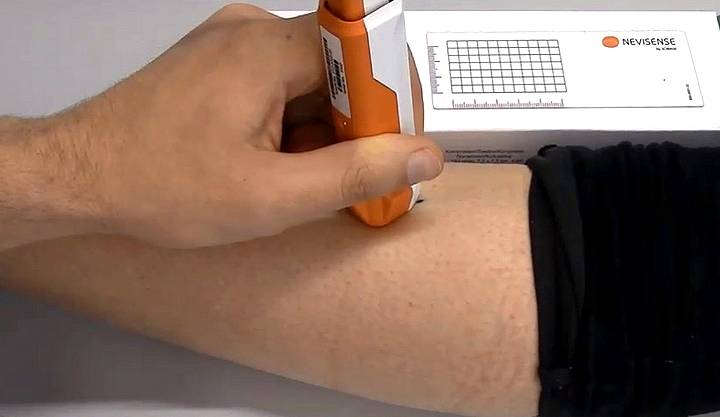
A non invasive yet effective way of diagnosing skin cancers, with particular sensitivity in detecting malignant melanoma.
The electrical properties of your skin change when melanoma is present. The latest electrical impedance spectroscopy (EIS) devices are able to pick up minute differences in electrical resistance this change brings.
A reference measurement from your normal skin provides a benchmark, before the hand held probe is used to examine a suspicious lesion, or mole. Testing is carried out across a range of frequencies and depth settings.
The probe is attached to a computerised base, which uses a mathematical algorithm to analyse readings. The lesion is given a score, which reflects any structural abnormality for cells in the area tested.
Testing is entirely safe, with disposable electrodes used for each patient and the level of electrical current very low. A no risk procedure, which brings valuable information for skin cancer diagnosis.
Objective Information
The data an EIS device provides is an unbiased scientific measure, which in a sense can not be wrong. Any variation from the norm has a cause and the type of differences melanoma can bring are factored in to analysis.
This is likely to have taken place when visual, or dermascopic examination raised concerns. The true value of EIS is as a tool used in conjunction with an experienced consultant’s initial, clinical view.
If you have a relatively obvious melanoma, they will have diagnosed this and arranged for treatment. EIS offers benefit for areas which are less clear. A tool which has helped the improvement in skin cancer survival rates.
Apart from assisting in bringing you vital early treatment when needed, the results can be conformation of an all clear. This avoids any need for surgical intervention, such as a physical biopsy, or removal.
A Proven Technique
EIS for skin cancer detection has been evaluated over a number of years, including a study across 5 US and 17 European medical centres. Nearly 2000 patients were involved, having around 2500 lesions of different types.
Varying skin cancers were tested with good results. In the case of malignant melanoma, a 94% detection rate and 98% for identifying more innocent lesions.
Further trails will help and EIS is best suited to areas with intact skin but as an additional diagnostic tool, electrical impedance spectroscopy has proven worth. A facility that a specialist skin cancer clinic should offer.
As with every diagnostic device we use, this assists in building an accurate picture and making the right treatment decisions. If we can help with further information on EIS for skin cancer treatment, please get in touch with either of our London clinics.
You may find the options below useful:
- Save time with an intuitive search on: Skin Cancer Diagnosis & Treatment.
- Up to date news, research and insights: Our Dedicated Skin Cancer Blog.
For any advice, or to arrange a dermatology appointment, call 020 8441 1043, or send an email via the Make An Appointment button below.
